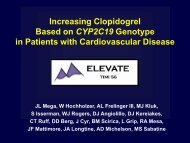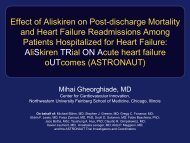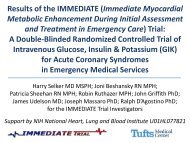Slides - Clinical Trial Results .org
Slides - Clinical Trial Results .org
Slides - Clinical Trial Results .org
You also want an ePaper? Increase the reach of your titles
YUMPU automatically turns print PDFs into web optimized ePapers that Google loves.
Pharmacist intervention to prevent<br />
hospitalization and death in patients with<br />
heart failure: A prospective cluster<br />
randomized controlled trial<br />
R Lowrie, FS Mair, N Greenlaw, P Forsyth, PS Jhund,<br />
A McConnachie, B Rae, JJV McMurray<br />
On behalf of the Heart failure Optimal Outcomes from<br />
Pharmacy Study (HOOPS) investigators
Background and Introduction<br />
• Disease-modifying drugs (e.g. ACE inhibitors and β-<br />
blockers) are under-used and under-dosed in patients<br />
with heart failure in primary care.<br />
• “Collaborative medication review” - pharmacists evaluate<br />
patients’ medications and suggest changes which are<br />
enacted with the agreement of the patient and the family<br />
doctor.<br />
• We hypothesised that pharmacist intervention to optimize<br />
medical treatment in patients with left ventricular systolic<br />
dysfunction would improve clinical outcomes.<br />
• Comparative-effectiveness, cluster randomized, trial in<br />
primary care
Patients: Inclusion and Exclusion Criteria<br />
• Inclusion: Left ventricular systolic dysfunction<br />
(confirmed by cardiac imaging). Patients did not have<br />
to have symptoms or signs of heart failure.<br />
• Exclusions:<br />
• Registration with heart failure-nurse service - provided<br />
to patients recently hospitalized with heart failure<br />
(excluded higher risk patients with more severe<br />
symptoms).<br />
• Concurrent disease (other than heart failure) likely to<br />
reduce life-expectancy; severe cognitive impairment or<br />
psychiatric illness; dialysis, or a resident in a longterm<br />
care facility.
Pharmacist Intervention<br />
• 27 pharmacists<br />
• 30 minute, face-to-face consultation<br />
• If changes were made (e.g. treatment initiation or dose<br />
modification), 3-4 additional consultations were<br />
arranged<br />
• All study pharmacists attended a training day which<br />
covered signs and symptoms and evidence based<br />
medical treatment of left ventricular systolic<br />
dysfunction
Primary and Secondary Outcomes<br />
• Primary:<br />
Death from any cause or hospital admission<br />
for worsening heart failure<br />
• Secondary:<br />
• Death from any cause or hospital admission for pre-specified<br />
cardiovascular causes<br />
• Death from any cause or hospital admission for any cause<br />
• Total number of admissions (and patients admitted) for heart<br />
failure, cardiovascular causes and any cause<br />
• Days alive out of hospital<br />
• ER visits, hospital out-patient clinics, primary care visits,<br />
• Prescribing of disease modifying medicines
Statistical Assumptions<br />
• Rate of primary endpoint in the usual care group 10%<br />
per year<br />
• Relative risk reduction in the primary outcome of 26%<br />
with pharmacist intervention<br />
• 2.6 years recruitment plus 2 further years of follow-up<br />
• Needed 673 patients to experience primary outcome for<br />
80% power to detect a difference between treatments.<br />
• Sample size inflated by a factor of 1.55 to account for<br />
cluster-randomization design - needed 87 practices/1044<br />
patients per group.<br />
• Due to longer than anticipated recruitment >750 patients<br />
expected to experience primary outcome providing 80%<br />
power to detect a 19% relative risk reduction.
Statistical analysis<br />
• The primary analysis compared the main outcomes<br />
between the treatment groups using a Cox proportional<br />
hazards frailty model.<br />
• Treatment effect adjusted for:<br />
• the stratification variables - level of socioeconomic<br />
deprivation (affluent, intermediate, deprived) and practice<br />
type (single-handed or group-practice)<br />
• and age, creatinine, grade of left ventricular systolic<br />
dysfunction, atrial fibrillation, respiratory disease, total<br />
number of medications and diuretic use.
Setting and Patients<br />
• The UK National Health Service – Greater Glasgow &<br />
Clyde Health Board. 1.2 million people ~25% of Scottish<br />
population.<br />
• Whole population registered with one of 220 family<br />
medical centers (practices); all centers invited to<br />
participate.<br />
• 174 of 220 centers consented (6620 patients with left<br />
ventricular systolic dysfunction).<br />
• 4451 patients declined/did not reply; 2169 (33%)<br />
patients consented and enrolled between Oct 2004 and<br />
Sept 2007.<br />
• Randomization by center (cluster-randomization<br />
design) to avoid “contamination”.
Study Outline<br />
Follow-up through NHS electronic records<br />
Median follow-up 4.7 years (range 6 days – 6.2 yrs)<br />
Cluster<br />
randomization<br />
Usual care<br />
(n=87 practices/1074 patients)<br />
2164 patients with<br />
left ventricular<br />
systolic<br />
dysfunction<br />
Pharmacist intervention<br />
770 primary events<br />
(n=87 practices/1090 patients)<br />
1 year 2 years<br />
Data<br />
Collection:<br />
Baseline characteristics<br />
Drug therapy<br />
Drug therapy<br />
Drug therapy
<strong>Results</strong><br />
• Baseline characteristics and treatment<br />
• Effect of pharmacist intervention on prescribing<br />
• Effect of pharmacist intervention on clinical<br />
outcomes
Baseline Characteristics (1)<br />
Characteristic<br />
Pharmacist<br />
intervention<br />
(n=1092)<br />
Usual<br />
care<br />
(n=1077)<br />
Age (years) 71 71<br />
Age ≥ 70 years (%) 55 55<br />
Female (%) 29 31<br />
Systolic/diastolic BP (mmHg) 127/72 128/72<br />
Degree of left ventricular systolic function (%)<br />
Mild 43 39<br />
Moderate 41 44<br />
Severe 17 17<br />
Principal cause of left ventricular systolic<br />
function (%)<br />
Ischemic 80 76<br />
Non ischemic/unknown 18/2 21/3
Baseline Characteristics (2)<br />
Characteristic<br />
Medical history (%)<br />
Pharmacist<br />
intervention<br />
(n=1092)<br />
Usual<br />
care<br />
(n=1077)<br />
Admission for heart failure in past yr. 2 2<br />
Hypertension 50 46<br />
Myocardial infarction 66 62<br />
Atrial fibrillation or flutter 27 28<br />
Diabetes mellitus 22 20<br />
Stroke 14 15<br />
Respiratory disease 30 30<br />
Asthma 7 8<br />
Smoker 24 25
Baseline Cardiovascular Medication<br />
Patients taking drug (%)<br />
Pharmacist intervention<br />
(n=1092)<br />
Usual care<br />
(n=1077)<br />
ACE inhibitor or/and ARB 87 85<br />
ACE inhibitor 75 71<br />
≥100% recommended dose* 60 62<br />
ARB 14 17<br />
≥100% recommended dose* 23 19<br />
Beta-blocker 62 62<br />
≥100% recommended dose* 22 20<br />
Aldosterone antagonist 5 5<br />
Digitalis glycoside 14 11<br />
Diuretic 61 61<br />
Antithrombotic 91 90<br />
Lipid lowering agent 79 78<br />
*Of patients taking drug
<strong>Results</strong><br />
• Baseline characteristics and treatment<br />
• Effect of pharmacist intervention on prescribing<br />
• Effect of pharmacist intervention on clinical<br />
outcomes
Changes in ACE inhibitor or ARB Prescribing<br />
(end of first year follow up)<br />
40<br />
40<br />
Pharmacist intervention<br />
Usual care<br />
35<br />
P
Changes in Beta-blocker Prescribing<br />
(end of first year of follow up)<br />
40<br />
40<br />
Pharmacist intervention<br />
Usual care<br />
35<br />
35<br />
30<br />
P
<strong>Results</strong><br />
• Baseline characteristics and treatment<br />
• Effect of pharmacist intervention on prescribing<br />
• Effect of pharmacist intervention on clinical<br />
outcomes
Death or Hospitalization for Heart Failure<br />
Death from Any Cause or<br />
Hospitalization for Heart Failure (%)<br />
50<br />
40<br />
30<br />
20<br />
10<br />
0<br />
Pharmacist Intervention<br />
Usual Care<br />
0 1 2 3 4 5<br />
Years<br />
Number at risk:<br />
Pharmacist 1092 1026 950 860 673 470<br />
Intervention<br />
Usual Care 1077 996 922 835 692 393
Components of the Primary Composite Outcome<br />
Heart Failure Hospitalization<br />
All-cause Mortality<br />
Hospitalization for Heart Failure<br />
(%)<br />
50<br />
40<br />
30<br />
20<br />
10<br />
0<br />
Pharmacist<br />
Intervention<br />
Usual Care<br />
0 1 2 3 4 5<br />
Years<br />
Death from Any Cause (%)<br />
50<br />
40<br />
30<br />
20<br />
10<br />
0<br />
Pharmacist<br />
Intervention<br />
Usual Care<br />
0 1 2 3 4 5<br />
Years<br />
Number at risk:<br />
Pharmacist 1092 1026 950 860 673 470<br />
Intervention<br />
Usual Care 1077 996 922 835 692 393<br />
Number at risk:<br />
Pharmacist 1092 1040 976 901 716 505<br />
Intervention<br />
Usual Care 1077 1018 957 880 737 423
All-cause Death or Cardiovascular Hospitalization<br />
Death from Any Cause or Hospitalization<br />
for Cardiovascular Cause (%)<br />
50<br />
40<br />
30<br />
20<br />
10<br />
0<br />
Pharmacist Intervention<br />
Usual Care<br />
0 1 2 3 4 5<br />
Years<br />
Number at risk:<br />
Pharmacist 1092 982 877 775 602 411<br />
Intervention<br />
Usual Care 1077 947 851 755 606 339
Summary and Conclusion<br />
• A low-intensity, pharmacist-led, collaborative<br />
intervention in primary care resulted in:<br />
• modest improvements in prescribing of diseasemodifying<br />
medications<br />
• but did not improve clinical outcomes in a population<br />
that was relatively well treated at baseline.
Discussion<br />
• High baseline use of ACE inhibitors/ARBs a surprise –<br />
UK Government “pay for performance” scheme for<br />
family physicians?<br />
• Consequently, less scope to initiate or increase doses<br />
of ACE inhibitors/ARBs.<br />
• More scope to improve β-blocker prescribing but<br />
pharmacists failed to initiate these drugs (and limited<br />
success in increasing dose). Why?<br />
• Low frequency of heart failure hospitalization and high<br />
proportion of non-cardiovascular deaths reduced<br />
likelihood of showing treatment effect.






